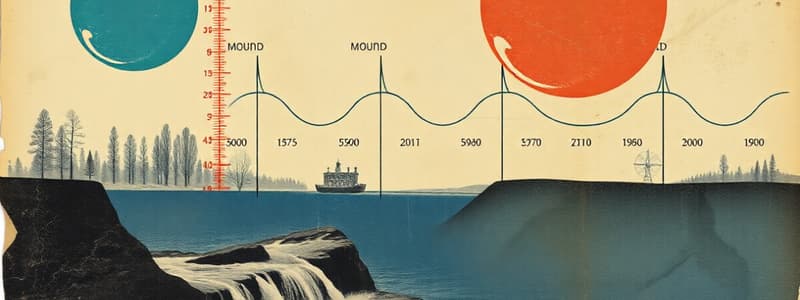Podcast
Questions and Answers
What is a flood warning?
What is a flood warning?
- Notification that floodwaters are receding
- A flood-control technique to manage water flow
- Alert for heavy rainfall expected in the area
- Advance notice that a flood may occur (correct)
What does a flood-control reservoir do?
What does a flood-control reservoir do?
- Stores water for agricultural use
- Generates hydroelectric power
- Temporarily stores flood water (correct)
- Holds water for recreational purposes
What is a flood wave?
What is a flood wave?
- Rise in streamflow to a maximum crest from various causes (correct)
- A sudden rise in temperature caused by rain
- A wave generated by strong wind in water bodies
- A gradual increase in streamflow due to drought
What does a frequency distribution indicate?
What does a frequency distribution indicate?
What is the purpose of a flowmeter?
What is the purpose of a flowmeter?
What characterizes a flume?
What characterizes a flume?
What defines the fresh/salt-water interface?
What defines the fresh/salt-water interface?
What does the term flooding refer to?
What does the term flooding refer to?
What is defined as the part of a hydrograph where discharge is decreasing from a peak?
What is defined as the part of a hydrograph where discharge is decreasing from a peak?
Which term refers to the highest elevation of water level during a flood?
Which term refers to the highest elevation of water level during a flood?
What describes the technique used to compute the movement and shape change of a flood wave?
What describes the technique used to compute the movement and shape change of a flood wave?
What corresponds to the probability of a flood of a specific stage occurring in a given year?
What corresponds to the probability of a flood of a specific stage occurring in a given year?
Which of the following describes natural marks indicating maximum flood stages on structures?
Which of the following describes natural marks indicating maximum flood stages on structures?
What is the term for the protection of land areas from overflow due to flooding?
What is the term for the protection of land areas from overflow due to flooding?
What type of gauge consists of a float that rises and falls with water levels?
What type of gauge consists of a float that rises and falls with water levels?
What term describes the nearly level land along a stream that floods only under high flow conditions?
What term describes the nearly level land along a stream that floods only under high flow conditions?
What is the definition of the peak-to-mean flow ratio?
What is the definition of the peak-to-mean flow ratio?
What does the Pearson distribution group relate to?
What does the Pearson distribution group relate to?
Which instrument is used to measure precipitation at a particular site?
Which instrument is used to measure precipitation at a particular site?
What does the term 'polder' refer to?
What does the term 'polder' refer to?
What is meant by potential evapotranspiration?
What is meant by potential evapotranspiration?
What does 'persistence' in hydrology refer to?
What does 'persistence' in hydrology refer to?
What is the probable maximum precipitation (PMP)?
What is the probable maximum precipitation (PMP)?
What does point precipitation refer to?
What does point precipitation refer to?
What does the term 'rating curve' refer to in hydrology?
What does the term 'rating curve' refer to in hydrology?
What is the primary purpose of a recording rain gauge?
What is the primary purpose of a recording rain gauge?
What does the recurrence interval indicate in hydrology?
What does the recurrence interval indicate in hydrology?
What is 'reservoir routing' used for?
What is 'reservoir routing' used for?
What is meant by 'remote sensing' in hydrology?
What is meant by 'remote sensing' in hydrology?
What does the term 'response function' represent in a hydrological system?
What does the term 'response function' represent in a hydrological system?
What characterizes a 'representative basin'?
What characterizes a 'representative basin'?
How is the 'rational method' typically expressed?
How is the 'rational method' typically expressed?
What is retention in the context of precipitation?
What is retention in the context of precipitation?
What does return flow refer to?
What does return flow refer to?
What is the significance of a return period?
What is the significance of a return period?
What does the rising limb of a hydrograph represent?
What does the rising limb of a hydrograph represent?
What does runoff refer to regarding precipitation?
What does runoff refer to regarding precipitation?
What is the primary purpose of a salt-dilution gauging method?
What is the primary purpose of a salt-dilution gauging method?
What does sediment concentration measure?
What does sediment concentration measure?
What is the definition of risk in the provided context?
What is the definition of risk in the provided context?
Flashcards
Falling Limb
Falling Limb
The section of a hydrograph where discharge decreases from its peak.
Flood Hydrograph
Flood Hydrograph
A graph displaying hydrological data like discharge over time.
Rising Limb
Rising Limb
The area of a hydrograph that displays how discharge increases to a peak.
Flash Flood
Flash Flood
Signup and view all the flashcards
Flood Crest
Flood Crest
Signup and view all the flashcards
Flood Forecasting
Flood Forecasting
Signup and view all the flashcards
Flood Frequency
Flood Frequency
Signup and view all the flashcards
Flood Marks
Flood Marks
Signup and view all the flashcards
Flood Plain
Flood Plain
Signup and view all the flashcards
Flood Probability
Flood Probability
Signup and view all the flashcards
Flood Routing
Flood Routing
Signup and view all the flashcards
Flood Warning
Flood Warning
Signup and view all the flashcards
Flood Wave
Flood Wave
Signup and view all the flashcards
Flooding
Flooding
Signup and view all the flashcards
Backwater
Backwater
Signup and view all the flashcards
Flow Duration Curve
Flow Duration Curve
Signup and view all the flashcards
Frequency Analysis
Frequency Analysis
Signup and view all the flashcards
Probable Maximum Precipitation (PMP)
Probable Maximum Precipitation (PMP)
Signup and view all the flashcards
Rate of Flow
Rate of Flow
Signup and view all the flashcards
Rating Curve
Rating Curve
Signup and view all the flashcards
Recession
Recession
Signup and view all the flashcards
Return Flow
Return Flow
Signup and view all the flashcards
Risk
Risk
Signup and view all the flashcards
River Basin
River Basin
Signup and view all the flashcards
River Bed
River Bed
Signup and view all the flashcards
Runoff
Runoff
Signup and view all the flashcards
Runoff Coefficient
Runoff Coefficient
Signup and view all the flashcards
S-curve
S-curve
Signup and view all the flashcards
Sediment Concentration
Sediment Concentration
Signup and view all the flashcards
Sediment Discharge
Sediment Discharge
Signup and view all the flashcards
Study Notes
Hydrograph
- Falling Limb: Portion of a hydrograph showing a decrease in discharge from a peak.
- Flood Hydrograph: Graph showing the variation of hydrological data, like discharge or stage, over a time period.
- Rising Limb: Portion of a hydrograph showing an increase in discharge leading to a peak
Flood
- Flash Flood: Flood of short duration with a high peak discharge.
- Flood Control: Measures taken to protect land from overflow and minimize flood damage.
- Flood Crest: Highest point of water level during a flood.
- Flood Forecasting: Predicting flood characteristics like stage, discharge, duration, and time of occurrence.
- Flood Frequency: Number of floods exceeding a specific discharge or stage over a certain time period.
- Flood Marks: Natural marks on structures or objects indicating the maximum flood stage.
- Flood Plain: Flat land bordering a stream, only flooded when the stream exceeds its capacity.
- Flood Probability: Probability of a flood reaching or exceeding a certain stage or discharge in a year.
- Flood Protection: Measures taken to protect land from overflow and minimize flood damage.
- Flood Routing: Techniques used to calculate flood wave movement and shape changes through a river reach or reservoir.
- Flood Warning: Advance notice of potential floods.
- Flood Wave: Rise in streamflow to a maximum crest followed by recession, caused by precipitation, snowmelt, dam failure, or hydroelectric releases.
- Flooded Area: The area covered by water when streamflow exceeds channel capacity or due to downstream damming.
- Flooding: Overflow of water beyond normal stream boundaries or water accumulation in non-submerged areas.
Other Terms
- Backwater: A raised water level in a stream caused by an obstruction.
- Flow Duration Curve: A curve showing the percentage of time flow is equal to or greater than given amounts, irrespective of chronological order.
- Frequency Analysis: Analyzing past hydrological events to predict future probabilities of occurrence.
- Frequency Curve: A curve relating the possible values of a hydrological event to its occurrence frequency
- Frequency Distribution: A specification showing how the frequencies of a population are distributed according to their variable values.
- Probable Maximum Precipitation (PMP): The statistical upper limit of precipitation for a given duration in a particular basin.
- Rate of Flow: The volume of water flowing through a river cross-section in a unit of time.
- Rating Curve: A curve showing the relationship between stage and discharge in a stream.
- Recession: Period of declining discharge following a peak, shown on the falling limb of a hydrograph
- Return Flow: Flow returning to a stream or groundwater after use.
- Return Period: The average time period for an event to be equalled or exceeded.
- Risk: The potential realization of unwanted consequences of an event, a combination of probability and consequence value.
- River: A large stream acting as the drainage channel for a basin.
- River Basin: An area with a common outlet for surface runoff.
- River Bed: The lowest part of a river valley, shaped by water flow and where sediment and runoff primarily move during interflood periods.
- Runoff: The portion of precipitation that becomes streamflow.
- Runoff Coefficient: Ratio of runoff depth to precipitation depth.
- S-curve: A hydrograph resulting from an infinite series of sequential excess rainfall increments.
- Sediment Concentration: The ratio of dry solid weight to water/sediment sample weight.
- Sediment Discharge: Discharge of sediments from a stream at a specific cross-section.
- Serial Correlation: Correlation between members of a time series and those lagging or leading by a fixed interval.
- Significance: An effect is statistically significant if the hypothesis that the effect is absent is rejected.
Studying That Suits You
Use AI to generate personalized quizzes and flashcards to suit your learning preferences.




